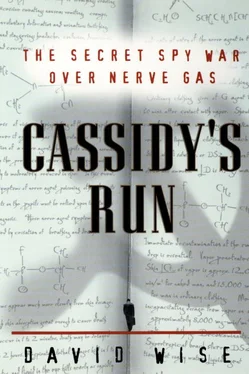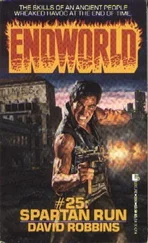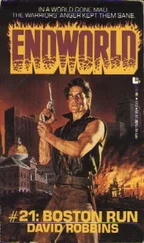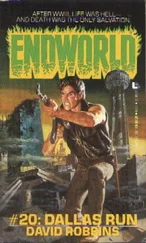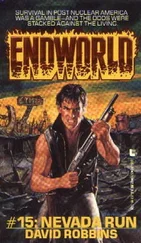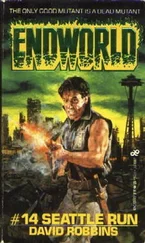Just to the north of Edgewood Arsenal is the army’s Aberdeen Proving Ground, a weapons-test area. “Aberdeen would take a shell and fire it to see the trajectory, strictly for munitions testing. Target effects were all done at Dugway,” said Hormats.
At Edgewood, the scientists concentrated primarily on sarin (GB). But they progressed to more compounds designated with letters of the alphabet, beyond GA (tabun) and GB. They skipped over GC, for fear that it might be confused with phosgene (CG), an older poison gas used widely in World War I. [7] Phosgene chokes its victims and can cause death by asphyxiation. It was also rumored among the scientists at Edgewood that GC was a code sometimes used in military medical records for gonorrhea.
The Edgewood chemists also experimented with soman (GD), and conducted research on a nerve gas designated only as GE, an ethyl version of sarin. They experimented as well with cyclo sarin (GF), a colorless, odorless nerve gas that is apparently as lethal as its cousins. According to Jeff Smart, Edgewood’s official historian, “We only standardized GB. We decided to declare it the main agent and produce it on a large scale.” Although no one at Edgewood would confirm it, there is some evidence that the scientists also may have conducted research into GH, a nerve gas that combines an organophosphorous compound with isopentyl alcohol. [8] Iraqi scientists working for Saddam Hussein reportedly developed a nerve gas that is an analogue of GH, using isobutyl alcohol.
The chemists at Edgewood were not content with this research. They strove at great length and at considerable expense to develop an even more powerful nerve gas. In the end, however, the technical problems they encountered were insurmountable. But this failure was to become the core of Operation SHOCKER.
From the questionsthe GRU asked Cassidy, it was clear the Soviets were anxious to know which nerve gases were being produced and put into weapons. Had the United States decided to choose one of the three gases, or was it developing more than one?
The GRU was also eager to discover whether the United States was developing a binary system to deliver nerve gases. In a binary system, the chemicals that combine to form nerve gas are kept separate—in two compartments in an artillery shell, for example—and mix only on approach to a target. A binary system is a much safer way to store the gas and reduces the danger to pilots and troops who must handle it. Moscow also wanted to know if the scientists at Edgewood might be working on newer and even deadlier forms of nerve gas. At a meeting in May 1965, Danilin asked Cassidy to find out the formula for the version of VX produced in the Edgewood lab. He gave Cassidy a hollow battery as a concealment device, as well as a specially treated sheet of carbon paper for secret writing. The carbon would enable Cassidy to send a message to the Russians on what appeared to be a blank piece of paper.
As it turned out, in asking Cassidy for information about binary weapons, the GRU was inquiring into matters at the cutting edge of American nerve-gas technology. According to William C. Dee, a veteran official at Edgewood, Ben Witten, chief of organic research at the facility, came up with the concept of a binary system in 1957. In a test chamber at Edgewood, and in field tests of VX at Dugway, it worked. [9] The precise way that binary nerve-gas weapons work is classified, but scientists familiar with them said that as the shell is fired, the contents push back in what is called a setback. The setback ruptures the disk that keeps the two chemicals apart. The rotation of the shell in the air mixes the two components. By the time the shell nears the target, the chemicals have mixed and produced nerve gas.
Saul Hormats, however, stopped the development of binary weapons in the 1960s. “It was put on ice by me for two reasons,” he said. “So that other countries wouldn’t get it. I didn’t want third-world nations making them in a barn in the boondocks. And second, it had no military value whatsoever. With the straight GB you had more agent in the shell; it is more efficient than the binary. The binary shell is a base ejection shell, which means the nerve gas shoots out the back of the shell and goes up in the air. With unitary munition it bursts right on the target. It is a different kind of shell, and it works better.”
The United States did not begin production of binary artillery shells until 1985, almost two decades later. By the late 1980s, 155 mm binary shells containing sarin were being produced, Dee said, each containing 6.5 pounds of the gas.
“I was furious when Reagan revived binary weapons,” said Hormats. But by that time, of course, he had retired and left Edgewood.
In March 1966,Danilin gave Cassidy a rollover camera, a spy gadget developed by the Soviets to copy documents that was a kind of predecessor of today’s handheld scanners. “The camera was about the size of a pack of cigarettes,” Cassidy recalled, “but not as thick.” Cassidy simply rolled the camera over the document, and it automatically took a picture. He could capture an entire page in three passes of the camera. Cassidy did not have to extract the film. “I would give the whole camera to the Soviets and exchange it for a new one.” Over time, the GRU gave Cassidy three rollover cameras.
FBI technicians examined these cameras, and one detail bothered Charlie Bevels. “They all had high serial numbers,” he recalled. “I wondered: Who else has these things?”
An indication of the GRU’s trust in Cassidy was the fact that Danilin did not interrogate him on where or when he was able to use the rollover camera without being seen. At one point, Danilin did suggest that Cassidy take the material into the men’s room to copy it. That was not an option, Cassidy explained; there were no doors on the stalls at Edgewood. “I could have taken the documents to my car,” he said. “But they didn’t ask, and I didn’t explain.”
The documents that Cassidy photographed and passed to Danilin were selected by army intelligence and approved at the highest echelon of the Pentagon, the Joint Chiefs of Staff.
One of those who ended up clearing the “feed,” as counterintelligence agents call such material, was Tom O’Laughlin, a former FBI agent who by 1962 had moved over to the Pentagon, as the direct result of a diktat by FBI director J. Edgar Hoover. According to Bevels, O’Laughlin ran afoul of Hoover’s edict that FBI agents had to meet strict weight standards. “Hoover had a physical and found that his weight was higher than the Metropolitan Life standard,” Bevels said. “He went on a diet and felt so good he decided everyone would have to do it…. [Tom] had a lot of trouble making weight.”
The problem with the feed, of course, was the need to balance Cassidy’s credibility with the requirements of secrecy. These contradictory demands could never be completely reconciled. As in every such operation, some secrets had to be given away in order to protect the double agent. Officials in Washington were thus passing secret information to the Soviets, the disclosure of which by anyone else could have resulted in a long prison term for violation of the federal espionage laws.
The difficult balancing act often led to tensions between the FBI and the Joint Chiefs. The bureau wanted to keep the Russians convinced by passing significant documents, but the Pentagon was reluctant to part with its classified secrets.
Bevels recalled the conflict. “It was hard to get the military to give us stuff. Sometimes we wanted to put classification stamps on documents that weren’t classified, and we had trouble getting clearances from the military even to do that.”
Читать дальше
